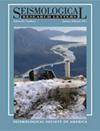Fireworks: A Potential Artificial Source for Imaging Near-Surface Structures
IF 3.2
3区 地球科学
Q2 GEOCHEMISTRY & GEOPHYSICS
引用次数: 0
Abstract
Abstract Seismic waves induced by incident acoustic waves from air disturbances can be used to image near-surface structures. In this article, we analyze seismic waveforms recorded by a dense array on the Xishancun landside in Li County, Sichuan Province, southwest China during the Lunar New Year’s Eve (27 January 2017). A total of eight event clusters have been identified as a result of firework explosions. For each cluster, which comprises dozens of individual events with high similarity, we manually pick arrival times of the first event recorded by the array and locate it with a grid-search method. We then rotate three-component waveforms of all events from the east, north, and vertical coordinate system to the local LQT coordinates (L, positive direction perpendicular to the landslide surface and pointing downwards; Q, positive direction is from the launch location of firework to the station along the landslide surface; T, perpendicular to the plane formed by the L and Q directions, and the selected positive direction of the T axis makes LQT form the left-hand coordinate system), and stack the LQT components for those events with cross-correlation values CC ≥ 0.8 with respect to the first event. Characteristics of the stacked LQT components are also examined. The particle motions at each station are retrograde ellipse in the frequency range of ∼5–50 Hz, suggesting air-coupled Rayleigh waves generated by the firework explosions. Spectrograms of the Rayleigh waves also show clear dispersions, which might be used to image near-surface velocity structures. Although we cannot directly extract the phase velocities due to the limitation of the seismic array, our study shows that the fireworks might provide a low-cost and easy-to-use seismic source for imaging near-surface structures.烟火:近地表结构成像的潜在人工光源
摘要大气扰动入射声波诱发的地震波可用于近地表结构成像。在本文中,我们分析了在农历新年前夕(2017年1月27日)在中国西南部四川省李县西山村陆面用密集阵列记录的地震波形。烟花爆炸一共造成了8个事件群。对于由数十个具有高相似性的单个事件组成的每个集群,我们手动选择阵列记录的第一个事件的到达时间,并使用网格搜索方法对其进行定位。然后,我们将所有事件的三分量波形从东、北和垂直坐标系旋转到当地的LQT坐标(L,垂直于滑坡表面的正方向,指向下方;Q,正方向是从烟花发射位置沿滑坡体面向站发射;T,垂直于L和Q方向形成的平面,选择T轴的正方向使LQT形成左坐标系),并将相对于第一个事件互相关值CC≥0.8的事件的LQT分量叠加。此外,还研究了堆叠LQT元件的特性。每个观测站的粒子运动为逆行椭圆,频率范围为~ 5-50 Hz,表明烟花爆炸产生的空气耦合瑞利波。瑞利波的谱图也显示出清晰的色散,这可能用于成像近地表速度结构。尽管由于地震阵列的限制,我们无法直接提取相速度,但我们的研究表明,烟花可能为近地表结构成像提供一种低成本且易于使用的震源。
本文章由计算机程序翻译,如有差异,请以英文原文为准。
求助全文
约1分钟内获得全文
求助全文
来源期刊

Seismological Research Letters
地学-地球化学与地球物理
CiteScore
6.60
自引率
12.10%
发文量
239
审稿时长
3 months
期刊介绍:
Information not localized
 求助内容:
求助内容: 应助结果提醒方式:
应助结果提醒方式:


